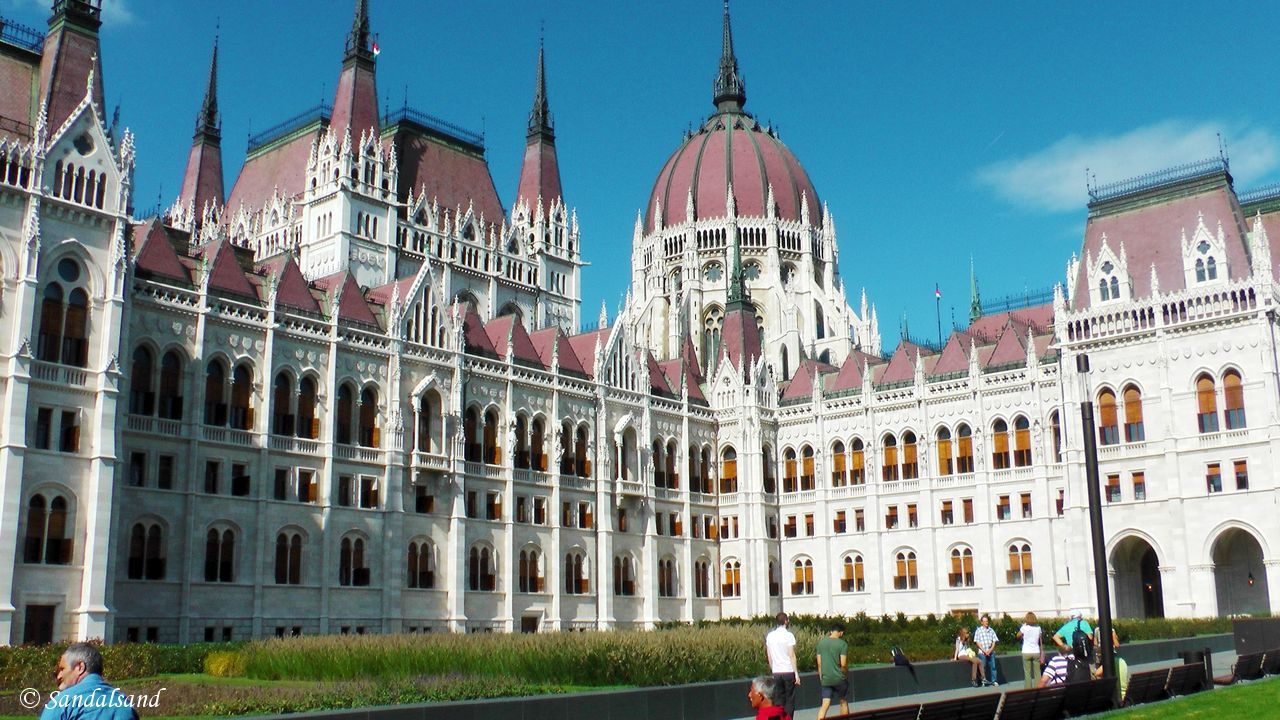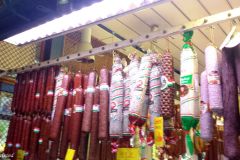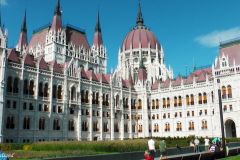The yellow Tram no 2 is the perfect way to transport yourself along one of the world’s most spectacular river fronts. Combine it with a walk on the Pest side of the Danube.
The Danube
The Danube River is the second longest river in Europe, after Volga, originating in the German Black Forest. It flows through or touches the borders of 10 countries before exiting in the Black Sea.
The Romans used the Danube as a protective barrier against the barbarians on the other side, setting up a string of fortified towns along the river. Budapest is one of them, but the river actually flows through three other capitals as well, Vienna, Bratislava and Belgrade.

Panoramic view of Budapest from the Gellert Hill. Buda to the left, Pest to the right. The bridge in front is the Elisabeth bridge.
It should come as no surprise that the mighty Danube (Donau in German, Duna in Hungarian) is wide. At one of the narrowest parts, at the Liberty Bridge, it is 280 metres wide. And this is where we start this combined walk and public transportation trip.
This walk
The map below shows the approximate and simplified routes to follow in Pest. This walk is the red route, marked #2. According to Google Maps the 4 km will take around one hour to walk. Zoom in and out of the map as you like and click on the markers. The map may also be expanded into a new tab.
Liberty Bridge and around
The bridge and the other side
The bridge itself is called Szabadság híd in Hungarian and is one of the most striking structures of Budapest. The elegant green-coloured iron bridge was finished in 1896 and opened by the Austro-Hungarian Emperor Franz Joseph, who also gave his name to it. It was blown up in 1945 but was gradually rebuilt to its former glory after the war.
You should walk out onto the bridge and admire the view upstream towards the Castle and the Gellert Hill high above the far end of the bridge. Look up and enjoy the spans and the statues on top of the two tower sections. Look down to see how fast the river flows and notice the cruise ships docking here. There are many cruise ships sailing the Danube from Vienna and south.
Down on the Pest side
The square on the Pest side of the bridge is called Fövám tér. There is an underground metro station here as well as a tram station. The square has been made into a pleasant little park over the last few years. To the left there are some nice gables and painted buildings and the popular (tourist) pedestrian shopping street of Vaci utca starts here going north parallel to the river.
To your right you will notice the very large building along the river bank housing the Budapest University of Economics. That is a building to be admired, but you should also visit the Great Market Hall next door. This market, the Central market or Nagycsarnok in Hungarian, is the largest and oldest indoor market in Budapest.
The market hall dates back to the late 1890s and resembles the railway stations of that time, with a lofty rounded roof and a steel skeleton. The ground floor behind the pretty portal has a large number of stands selling all kinds of food: meat, pastries, vegetables and so on, while the open second floor contains souvenir shops and restaurants.
At the river end of the Fövam square there are entrances to underground tram and metro stations. As with many metro stations in Budapest the signposting is terrible and they have done their utmost to hide the “M”. This one is easier to find. There is a ticket vending machine downstairs where you can purchase your tickets. The 24 hrs or 72 hrs cards are quite affordable and valid on all public transportation in Budapest – metro, tram and buses. A lot of tourists spend hours and 20 euros on the numerous hop-on hop-off buses, but public transportation is perhaps even better for a foreign visitor.
Wait for tram number 2 going north. The charming old, yellow trams of Budapest reminded us of the ones in Lisbon. You may well get off the tram at the next bridge, but read the following section first.
Elisabeth Bridge and around
This white cable bridge, Erzsébet hid in Hungarian, has a very different look than the other two bridges described. It was not reconstructed after the war in its original form. It was reopened as late as 1963.
There is not really much to see around here. You could have a glass of Hungarian wine and some goose liver at one of the cafes next to the tram stop. Better still, you could walk up the road leading onto the bridge and check out the Parisian Court building on the left hand side. Read about it in the first article from Budapest.
In other words, you might as well stay on the tram and continue one more stop and get off before you reach the tram stop at the Chain Bridge.
Chain Bridge and around
Squares and a cafe
My suggestion is to get off the tram no 2 at a nice, little square called Vigadó tér. Walk straight up from the river and you will soon reach the much larger square called Vörösmarty ter.
There is a statue in the centre and splendid architecture all around. Aim for the large, old Gerbaud building on the northern side of the square. Café Gerbeaud is a wonderful coffeehouse, one of the oldest and most traditional ones in Europe. Sit down outside, weather permitting, or seat yourself in one of the numerous salons inside. Order coffee and one of the chocolate cakes on display in the counter. You will not regret it, it will guaranteed be one of your dearest memories from Budapest. Their confectionary is for sale, but the chandeliers, stucco ceiling and rare wooden panels are not.
Restaurants, palaces and a bridge
We retrace our footsteps to the riverfront and find a string of restaurants towards the bridge up front. If the weather is nice you should take another break here and admire the view across the river. The castle area on the Buda side is a mighty sight.
There are a number of boring multinational hotels clustered around the Pest side of the upcoming Chain bridge. One of them sticks out on the positive side. The Gresham Palace used to be an combined office and apartment block, built in 1906 in Art Nouveau style, for a British company. After the war the building fell into decay before it was finally acquired by an international hotel chain. It is monumental, inside and out.
And now finally, the often proclaimed gem of Budapest’s bridges. The Chain Bridge (Széchenyi Lánchíd) was opened in 1849 as the first bridge in Budapest.
The sights on the other side of this bridge will be described in a later article. See below.
There is a long walk on the river promenade to our final destination, and you may want to grab the number 2 tram again. Before you reach the parliament there is one important memorial to pay attention to.
The shoes
The shoes on the Danube may look and sound like a very special memorial. And it is.
There are a number of shoes, of all sizes, made of bronze, on the edge of the river bank. They represent Jews who were forced to take off their shoes before they were shot and fell into the river. There is a sign stating this: “To the memory of the victims shot into the Danube by Arrow Cross militiamen in 1944–45. Erected 16 April 2005.”
See if you can find the children’s shoes. This is a gripping memorial.
The Parliament
Coming up as our last stop on this combined walk and tram ride is the Hungarian Parliament. Most of the building from 1904 has a Gothic resemblance although other styles were employed as well. It looks very much like Westminster in London, but is larger.
The Parliament is an extraordinarily impressive building, and it is part of UNESCO’s World Heritage List along with more structures in central Budapest.
Read more
Several of the places mentioned in this article are part of the World Heritage Site officially called “Budapest, including the Banks of the Danube, the Buda Castle Quarter and Andrássy Avenue”. Read more.
You may also read the other articles from this trip to Budapest in September 2014.
(1) Harmonious gardens and hidden courtyards
(2) The Pest side of the Danube
(4) The Buda side of the Danube
In addition to the walk, you should not miss a river cruise.























